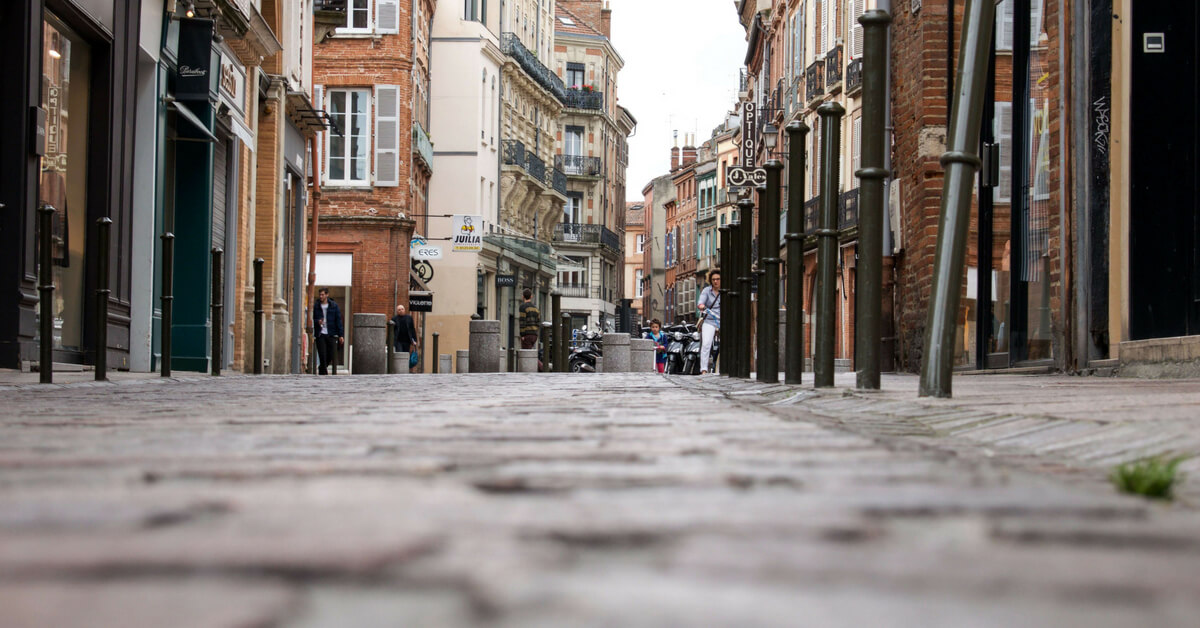Table of Contents for this Episode
Category: Alsace and Lorraine
On today’s show we explore the city of Strasbourg in the region of Alsace. But first we want to say thank you to the listeners who wrote us new reviews in iTunes: Jason Van Orden, Buggsy2, Ator88, tlobner, and Sharkgurly. Special shout-out to Laura K Lawless of About.com French Language and a big welcome to the new listeners who found us through her work.
We’re going to begin today with some background information about Alsace. In France there are departments, these are comparable to very large counties in the USA. And there are also regions that divide the country from an administrative point of view. Regions are made up of a group of departments and they have very specific culture and history. Regions are separate one from the other. Some of these regions people have heard of, Normandy for instance, but at his last is very different from all the others. So will begin with talking about the region about last and then we’ll get into the city of Strasbourg itself. Alsace is in the northeastern part of France, it is actually bordered by the Rhine River and on the other side of the river is Germany. Yes, very very close to Strasbourg. In Strasbourg is you cross the bridges over the Rhine you end up in Germany. It’s a very international city. What makes this region strange is that it’s the only region that has been buffeted back and forth between France and Germany. The architecture in Alsace is much more Germanic, it’s quite like what you imagine from the fairy tales of the Grimm Brothers. So you will find a lot of “maisons à colombages” which in English is half timbered. You expect little red riding hood or pencil and Gretel to come out of the woods somewhere in that area.
Annie will put pictures of the area on joinusinfrance.com/18 but also you will find a new tab on top of the website called Photos and this is where I put photos about places that I’ve visited and write short articles for the places that we have not podcast about yet. I do that because am impatient to share! So if you want to see lots of photos about vast you can visit both joinusinfrance.com/18 or look at the photos tab.
The Alsace Region
Alsace is a region that goes back very far as much of Western Europe does. It was settled originally by Germanic tribes, this is very specific to the area, because they were there even before the Romans who basically conquered most of Western Europe. They settled in that area and never moved. And what I found out while doing research about this area is that the dialects that half of the population there still speaks today. Everybody learns French at school, but there are small villages where people talk to each other in the dialect instead of French. This is a dialect that goes back almost 1600 years. It’s an ancient Germanic dialect. It is not like modern German, although people who speak German can understand most of what they say, but it’s a specific dialect that didn’t involve that much and it’s in this region which includes a couple of departments: one is the lower Rhine (Bas Rhin) the other is the upper Rhine (Haut Rhin), and the Moselle. Some of the major cities are Strasbourg, Colmar, and Mulhouse. And these are areas where lots of people still speak to this unusual dialect. It is not German, it is Alsatian. And if you meet people from that area they will make it very clear that they are not German, they are Alsatian. That language does sound like German to French people because it’s pretty close.
So this area was settled by Germanic peoples and they were invaded by a group called the Franks, and we know that the Franks gave the name to this wonderful country that we’re in called France. And the Franks were also Germanic people, but they were separate try. This is way back when where people lived in tribes and they didn’t like anybody and they would push people out and moving themselves. So the Franks who were larger and more powerful group they had taken over what is now Belgium, Luxembourg and the northern part of France. Were talking about the 600s and 700s. So they came into this region that were peopled by other Germanic tribes, and they conquered them. But they did not push the people out, they just mixed in with them, and they became part of the Frankish Empire. And the men who is most famous from the Frankish Empire is Charlemagne. Carolus was his name in Latin. He was the grandson of the Frankish king who had united all of these tribes to become a kingdom. In France the art statues of Charlemagne everywhere because he is considered to be the father of this country called France, but in fact he was German, or at least Germanic. This is why it’s silly when people go nuts over this kind of thing because were all the mixture at some time or another.
The Birth of the City of Strasbourg
Charlemagne was the first one to create a little bit of the city in the space we now call Strasbourg. And this was because it was on the Rhine and these people use the reverse for transportation and for defensive purposes. They built fences along the Rhine River back and forth, and this goes back as far as the Romans. And the original name of Strasbourg was Argentorate which doesn’t sound anything like Strasbourg. This is a name that disappeared after Charlemagne took over. And the region stayed Germanic for a very long time because in the history of Western Europe, and specifically the history of what became France, Charlemagne kept a unified area. It is the same idea as will we have now with the European Union. This is the kind of thing he was trying to do, of course in those days he was mostly doing it with armor and swords, not quite what we do today. There was France and Germany and northern Italy, all of that was part of his kingdom.
Charlemagne’s Descendants
Charlemagne’s oldest son gave his kingdom to his three sons (grandchildren of Charlemagne’s), but at that time you could not give all planned to the oldest son, you had to divide it up among the sons. At the time daughters didn’t get anything, they got a dowry, they get married off to somebody else. There were three sons: Louis, Charles the bald (whose father was Pépin le Bref which means he was short), and Lothaire. The second and the third sons got together and decided they didn’t want to divide this picking them up and give Lothaire the biggest portion, and without killing him they went to see their big brother and said we want you to sign this agreement with us and they just gave him this small couple of areas to take care of himself. Maybe he seemed incompetent or maybe the brothers were greedy. But he agreed, see you wonder what was going on, but he agreed.
How France and Germany Were Born
So Charles the bald and Louis divided up all of this, and they basically cut it in half, and there we have France and Germany. So with some changes along the border along the Rhine River we have had the idea of what is France and what is Germany established for 1000 years. But through all of that this region called Alsace does not change, it’s a separate independent region. And somehow they manage to stay an intermediary region between Germany and France, and kept their Germanic language all throughout this time. During the time of the Renaissance, the people in this area were forced by the French King to start speaking French. Because in terms of what kingdom in belonged to it was part of France, but in affinity and culture it was closer to Germany. So, starting in the 14 and 1500s, these people were forced to start speaking French, but in their homes they continue to speak the dialect. And the architecture of the area is much more Germanic than it is French. And it has stayed that way all through these centuries.
The Free City of Strasbourg
Up through into the Louis XIV, Louis XV, Louis XVI, this remained a separate area with a free trade agreement and the city of Strasbourg became very important because it was on the river, and because it was allowed to be (like other cities in Western Europe) a free city. Free City means that it was a trade zone with special taxes, initiatives, and a buffer zone between France and Germany. It stayed prosperous for many centuries and still is today. It is one of the most prosperous cities in France. The city continues to develop and there are a lot of vineyards all over the Alsace region.
Climate
Alsace is situated on the eastern side of low old mountains called the Vosges mountains, they are like the Appalachian mountains in the US because they are the oldest mountains in France, they are not very high. But on the western side they collect enormous amounts of rain and snow coming from the Atlantic, and on the eastern slopes you have a lot of sun and the soil is different. Since Roman times they have used the slopes on the eastern side of Alsace to grow wine grapes. Alsace makes very good wine. The villages are usually very beautiful and the area is really sunny. It has a continental climate but with lots of sun.
Thirty Years War Between Protestants and Catholics
In 1681 Louis XIV (our guy from Versailles, episode 14) attacked the city of Strasbourg because it wanted to keep its independence. There was a lot of fighting between the Catholics and the Protestants. Strasbourg was one of the first cities to move to the Protestant religion in large part due to Luther who put one of his first edicts on the Cathedral of Strasbourg. The whole region quickly moved to the Reformed church, which is what it is called in French. In order to accommodate everybody they actually divided the Cathedral of Strasbourg in half, they put up a wall inside of that huge church and on one side they held Catholic services and on the other Protestant services as a way of appeasing the people. It was their attempt to stop war. There was a period called the Thirty Years War and it was the Catholics and the Protestants fighting one another. Louis XIV said enough is enough and he attacked the city with 30,000 troops and they gave up quickly because they weren’t prepared for that kind of fight. In 1681 the city of Strasbourg officially became part of France and it stayed French until 1870 when the Prussians attacked France.
Germans Take Back Alsace and Loraine in 1870
Prussians took Strasbourg and Alsace back as well as another region called Loraine next to it and they made it German again. The Alsatians didn’t want to be German but they didn’t really want to be French either, even though they had gotten used to being French. They wanted to be Alsatians. Strasbourg ended up being the key city in all of this because it is on the border of the two countries and because it was a really prosperous city with a large university since the Renaissance. The area stayed German from 1870 until the end of WWI when the Western forces won WWI, Alsace and Strasbourg went back to being part of France.
WWII in Alsace
In 1940 Alsace was taken over again by the Germans. By this time there was an enormous amount of resistance to this. In the past there was a sort of passivity about it from the locals who were used to being told now you’re German and now you’re French but were basically left alone to live their lives. In 1940 when Alsace and Strasbourg were taken it was quite different. There was a massive exodus from the city of 120,000 people and those people who stayed were mostly casualties of the war, and a lot of the men who were in Alsace were taken to do forced labor in Germany, some of them were sent to the Russian front and most of those never came back.
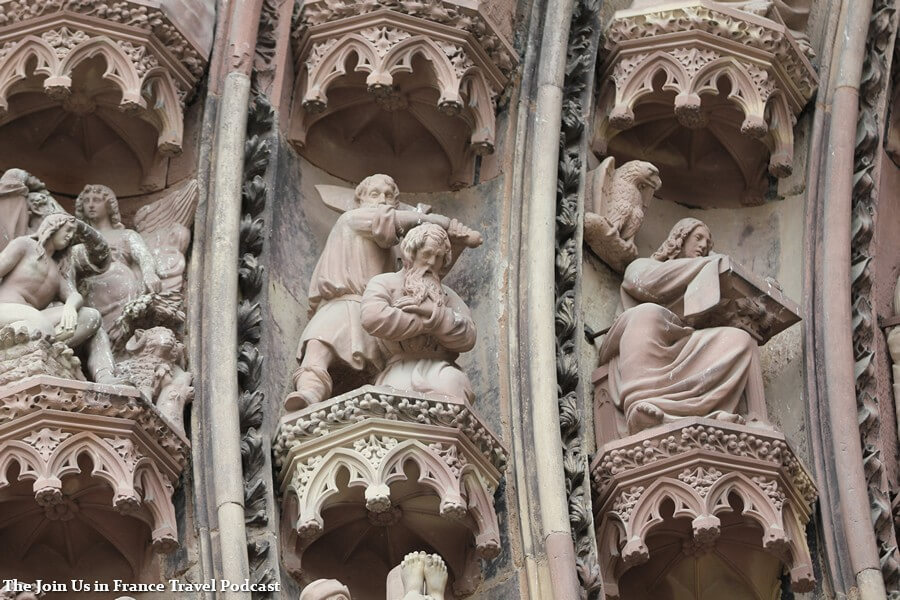
Because Alsatians spoke German, the French didn’t trust them even though they considered themselves to be French. A lot of them were put in prison even though they had done nothing, a lot of them were ostracized, and in order to prove themselves loyal a lot of the men went to fight in the southern part of France because it was as far away to where they came from as possible, but there was a lot of antagonism against them, it was a sad episode in their history and it’s a shame.
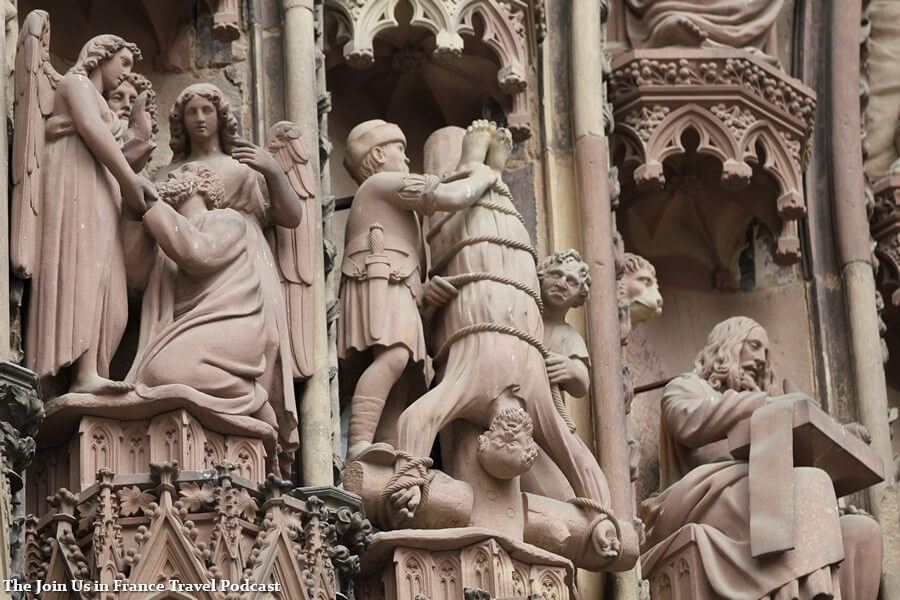
La Marseillaise
Something that most people don’t know is that the song that we know as La Marseillaise, the French national anthem, it was written by somebody in Strasbourg. It’s a song that was written by Rouget de Lisle during the French Revolution. The song was originally called A Song for the Army of the Rhine Fighting Against the Germans. It wound up being called La Marseillaise, even though Marseille is far away from Strasbourg, because during the French Revolution the song was sent around to the various groups that was fighting in the Revolution and the first unit that walked into Paris singing the song was from Marseille. That was in 1792 and that’s why they call it La Marseillaise.

The “Serments” (oaths) of Strasbourg
Going Back to the Times After Charlemagne when his grandsons were setting up their deal to divvy up the land between France and Germany, the two sons who got along because they didn’t kill each other off, they did something incredible. They created something called the Serments de Strasbourg (Oaths of Strasbourg), it’s a document that still exists, found at the Bibliothèque nationale de France in Paris. They wrote a treaty, one son wrote his in the Germanic dialect and the other in the language that would later become French. This document became the first written document in French. Prior to that everything was written in Latin. http://fr.wikipedia.org/wiki/Serments_de_Strasbourg
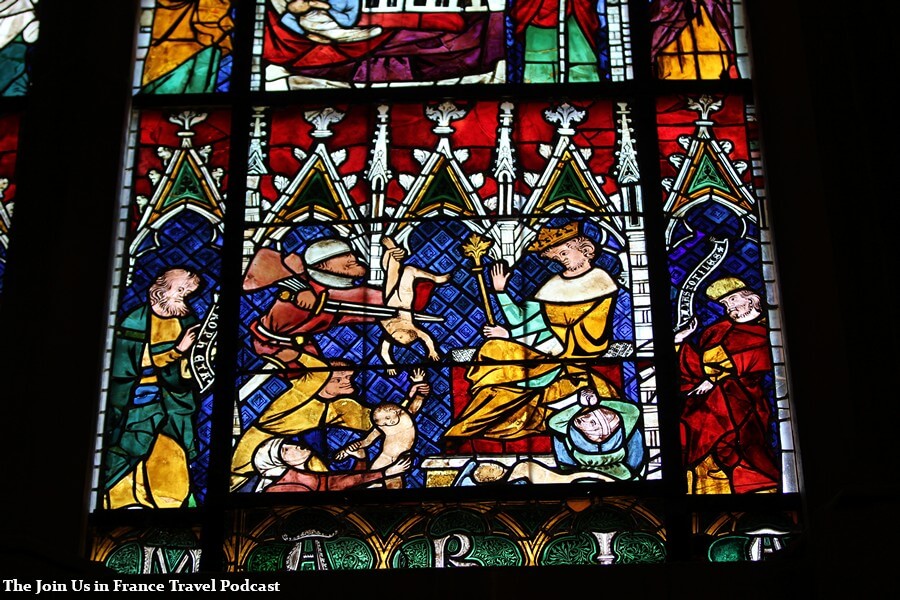
After WWII
There were payments made for damages. There was a lot of suffering, young women taken into forced labor, they were also treated very poorly by the French people for a while, it’s quite sad what happened, but it wasn’t their fault. They really have this separate culture and dialect, and in the villages you still feel that, but not in the big cities such as Strasbourg. They didn’t seem to Annie to have strong local accent when they speak French in Strasbourg (although this stand up comedian from Mulhouse certainly makes a big show of it! http://www.dailymotion.com/video/x9hssr_thierry-se-fait-remarquet-accent-al_fun)
Colmar is a city south of Strasbourg, and it’s very beautiful, they speak more Alsatian there. In the village of Riquewihr, a gorgeous little village in the area (http://en.wikipedia.org/wiki/Riquewihr)
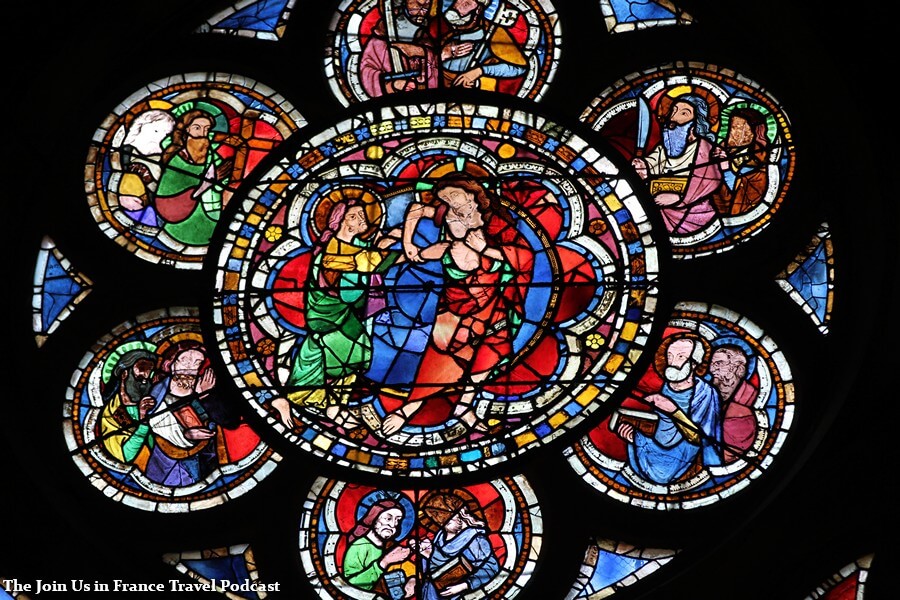
Strasbourg the European City
Strasbourg is the 7th largest city in France, the metro area of Strasbourg is around 750,000 people and at least half of that is not originally Alsatian. It attracts people from all over France and also the European Parliament is there.
Strasbourg also has a huge university, it has a lot of research, has a lot of medical research. It is economically one of the most vibrant cities in France and in Western Europe. It’s a city that has a lot going for it, besides the beautiful historical parts. The entire city center is a UNESCO world heritage site, so everything is preserved in Little France, which is this old section in the middle of the river. And it has a sense of history when you walk through it.
Paris is 397 km away, that’s about 250 miles. Zürich is 185 km away. Stuttgart is 136 km away. It’s 750 km away from the Atlantic or the Baltic Sea. It’s 500 km to the Mediterranean. It’s in a very
central part of Europe. That’s what it with the European Parliament there. Yes there’s another reason, give me a minute to find a quote, why don’t you start talking about your experience in Strasbourg.
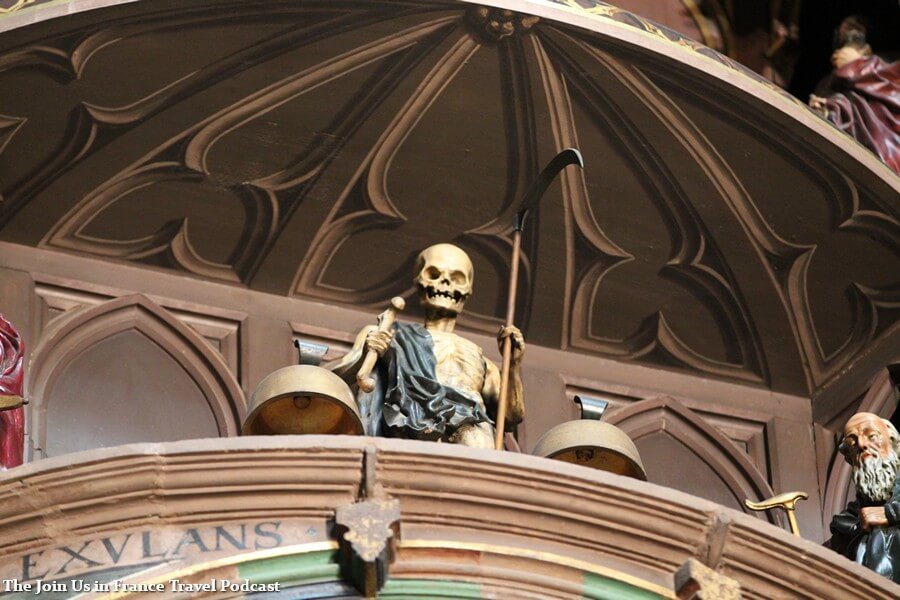
Annie’s Experience in Notre Dame de Strasbourg
We went for a short 24 hour visit, because we were visiting family in Stuttgart. I was astonished by the city, although it’s quite similar to what I had seen in Germany, but the church in particular made a big impression on me. First of all, it’s massive, it’s a massive caustic church. What I loved is that I had brought camera equipment, and I was able to zoom in on details of the church and they were all just wonderful. This is a strange thing that I like to do, when I go to
churches I like to look for disturbing things. I like to look for the gory stuff. I like to look for the decapitation, and the terrible devils, and the scenes of hell. And I can find it in most churches, if you look close enough and with a good zoom lens you will find it. And I was delighted how cunningly they had hidden all these terrible scenes! It’s a little bit like Halloween. But, the church is beautiful, the stained-glass windows are wonderful. And the thing that I particularly loved although I can take good pictures of it because my wide-angle broke on this trip, is the astronomical clock in this church. It is just
gorgeous, I have pictures and details of it. And every hour you have the little people that come out, it’s like the cuckoo clock, a giant cuckoo clock. It shows the stars, and the planets, and it still works and it’s gorgeous. And in front of it they also have this large pillar full of statues it’s called the smiling Angels pillar, and it’s also very spectacular. On the other side of the church they have a beautiful Bas-Relief that looks like war seems to me.
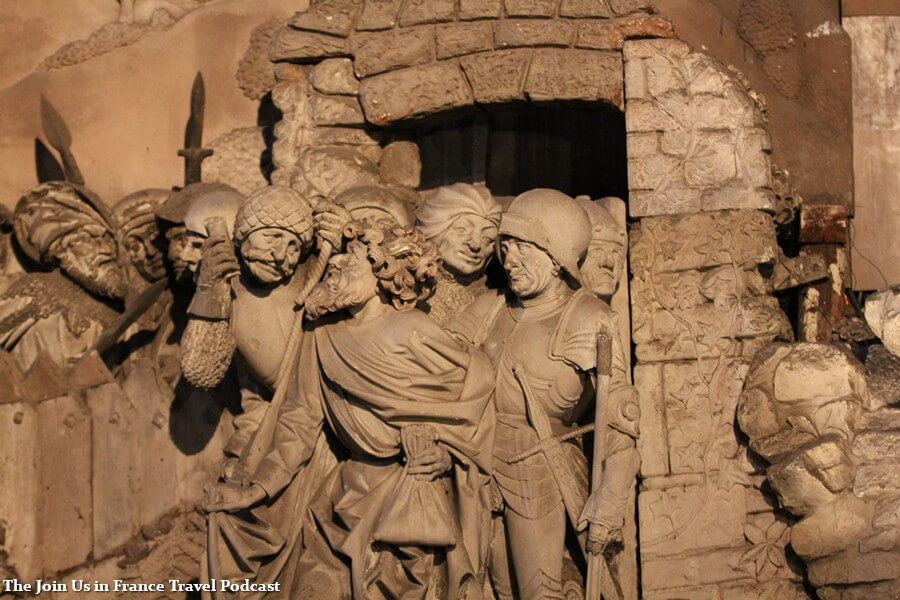
Notre Dame de Strasbourg
The church is called Notre Dame de Strasbourg and it’s made of pink sandstone. It’s very beautiful but a lot of it is the black due to pollution, it is sooted. They started to clean up in parts, but I think they need to put a big effort into that because a lot of it looks dark on the outside. What happens with churches like that is throughout the centuries the pollution gets absorbed by the stone and makes it black. And unfortunately, it’s an extraordinarily expensive thing to
clean up. I would assume they are going to do it little by little. They did that with the Cathedral of Reims that we talked about in episode 13, and Notre Dame de Paris (episodes 4, 5, and 6). And you have to do that or it’ll eat away at the stone.
The construction of Notre Dame de Strasbourg was begun in the very early 1200s. The spire was not actually put on until almost 400 years later. It took that long to completely finish it. It’s very tall, it’s about 158 m I think. It is a late Gothic, and one of the reasons it took so long to finish is the wars. So every time there was some kind of fighting in the region everything stopped, and you don’t keep on building at that time. By the time they did the spire, everything had calmed down.
It’s a little bit difficult to get good pictures of it because you can’t step
back very far. The buildings around it are very close so you really need a good wide-angle and mine was busted. There’s only one side that has a big open Esplanade, but even that you see it through a street. It’s not like Notre Dame de Paris where he can step back and see the whole thing very well. The buildings are probably 20 m away. And it is a fact that at the time that these cathedrals were built, and this is true of all of them, they were built in the middle of this very congested housing from the Middle Ages, and it’s really meant to look like
an eruption. It’s this impression that the Cathedral is this humongous thing that just rises out of all these little houses. And what’s interesting is that in Strasbourg is the one of the few that has been maintained like that. In most of the places they’ve cleared out the areas around the churches. Well they have such beautiful houses right around the Cathedral it would be a shame to tear them
down.
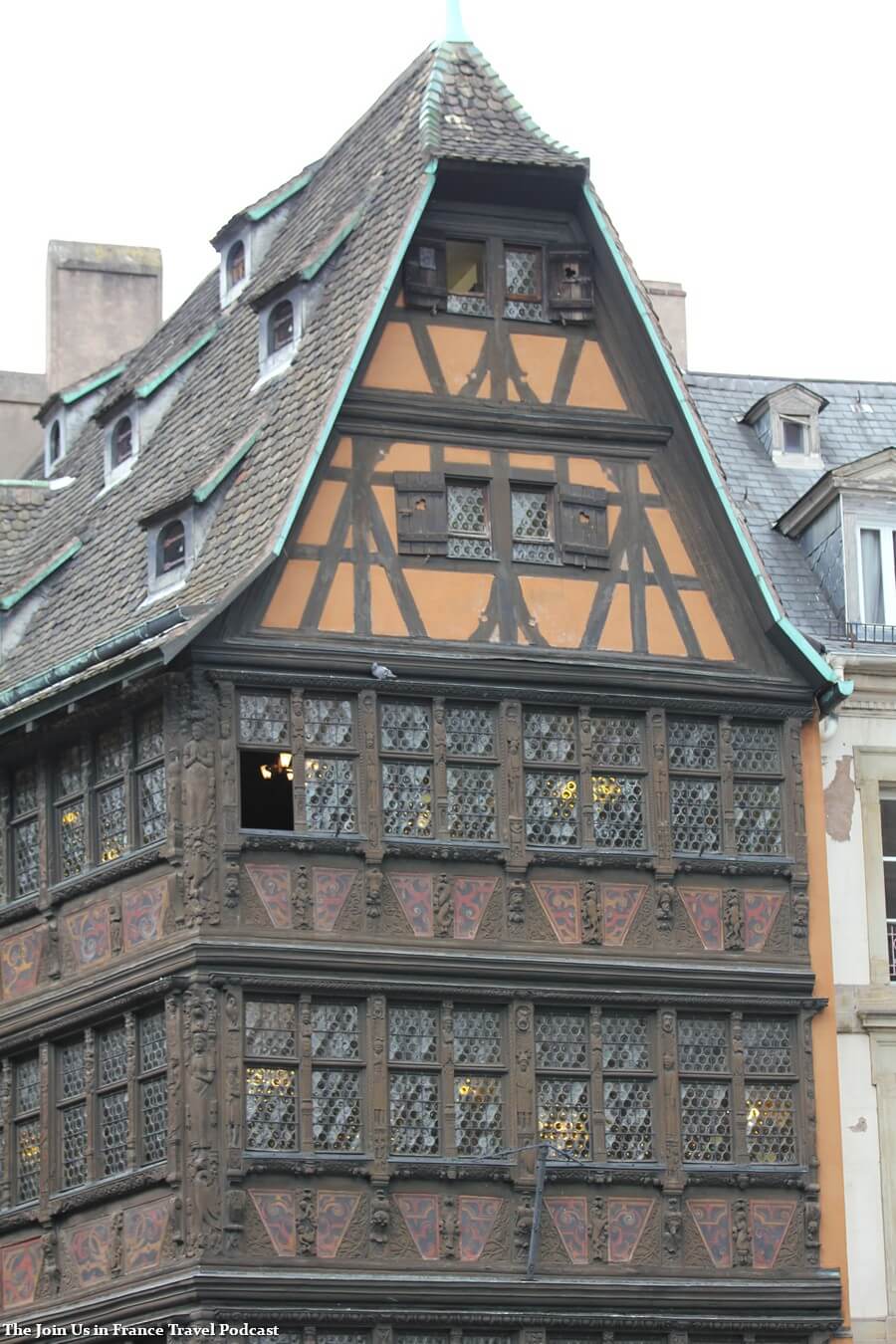
Because it is much more German in its style of architecture, it is very beautiful to see all these little half timbered houses. Strasbourg and Alsace in general are famous for being places where people take very good care of things. And it is relatively clean. And the village is a very beautiful and clean too. So everything is well taken care of. And the whole old section where all the houses are from the 1500s and 1600s is all part of the world UNESCO site, and it has to be kept up.
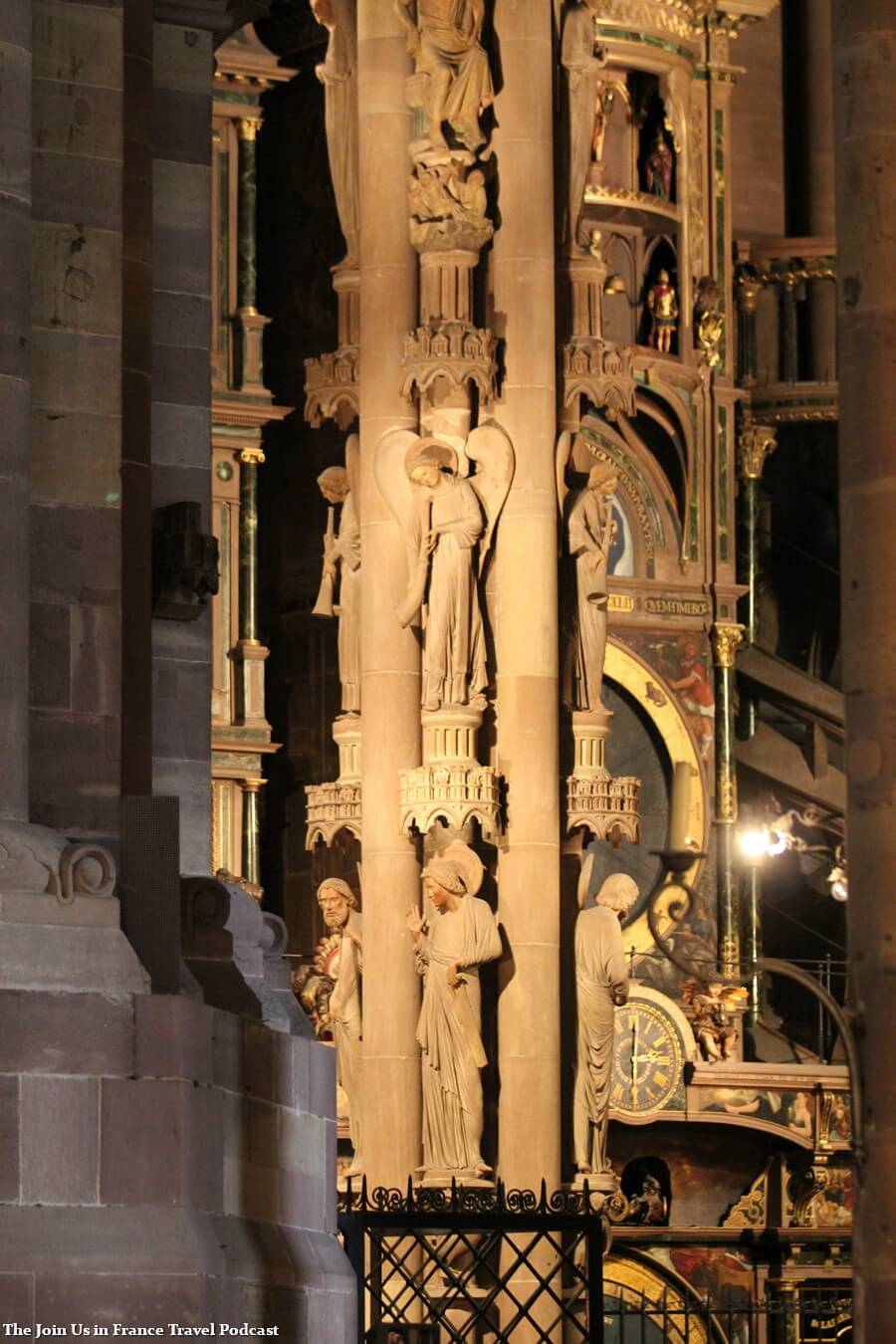
Modern Strasbourg
Strasbourg is a very dynamic city. The city center is absolutely gorgeous with its waterways and old houses. They have canals, you can take boat rides on the canals.
Here is the quote I was looking for earlier: the British Minister of foreign affairs. Right after World War II is when they decided they were going to make an effort to establish not just the United Nations but also the European Community so that there would be no more war. Let’s face it, the 20th century was absolutely devastating for Europe. And where they were trying to decide where to
set up the very first European Council in 1947, this is just two years after the end of World War II, the British minister said and I’m quoting “we are looking for a place, a city, which will be acceptable to all European countries, and which will become a symbol of a united Europe. Strasbourg seems to be the most logical choice. This great city has been victim of, and witness to, the stupidity of humans who have tried to deal with problems with war, cruelty, and destruction.” And so, they made Strasbourg the seat of the European Council. It
is also the seat of many other organizations that are at the center of the European Community. Those institutions are shared with the city of Brussels in Belgium. But Strasbourg is the seat of the Court of human rights, of the European Parliament. And unfortunately you cannot visit the European Parliament very often. They have a few special opening days, but it’s only a few times a year and there are no organized visits.
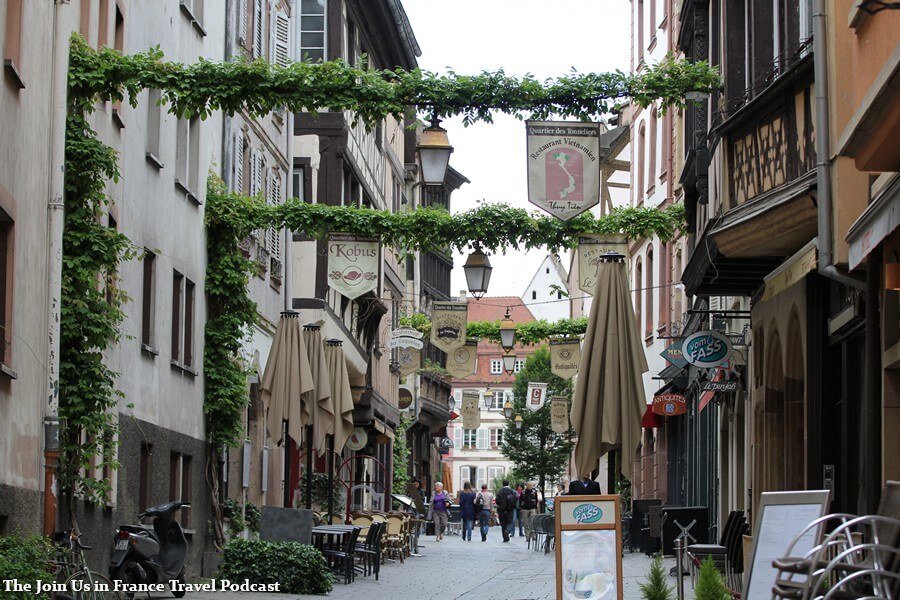
But we got a small glimpse into it just sitting at a café. There was a young lady in a much older man sitting next to us, and they were obviously discussing school, she was a student. And at one point the man get out an article from a newspaper, they had been speaking in French, once in a while they switch to English but it was mostly French, and what he was having her do is read an article in French and simultaneously translated into English. This was interesting to me because most of my career and technical translator, but not a
simultaneous translator that’s a very different skill set. I was flabbergasted how fast could read something in French and say it’s in perfect English. She was really really good, and the men was coaching her as to what to practice. Apparently that’s how they practice, I didn’t realize that’s how they would do it. You read something at a normal pace in one language and say it in another. In Europe we have all these languages and in the European parliaments you have to have translations of everything. They translate everything but not in all language pairs. You have German, French and English that are the lingua franca. Not Spanish? We don’t know. We wonder how they decided to make English the official language of the European Union, especially considering that England itself is recalcitrant, and doesn’t particularly want to be a part of the European Community, at least some parts of England feel that way.

They became the home of the European Council officially in 1949, the European Parliament in 1952, the European Court of human rights (which basically covers all human rights everywhere in the world) in 1998. It is a city that has become a symbol of all of that. It has a lot of biotech industry, it does a lot of pharmaceutical research, it has a huge University and a major theater and opera. It has maintained this kind of Renaissance city quality to it because it is really all of those things. If you’re visiting France and you have never been to that part of France (and I had never been myself) we both think it’s well worth a visit. It is different, but in a very pleasant way.
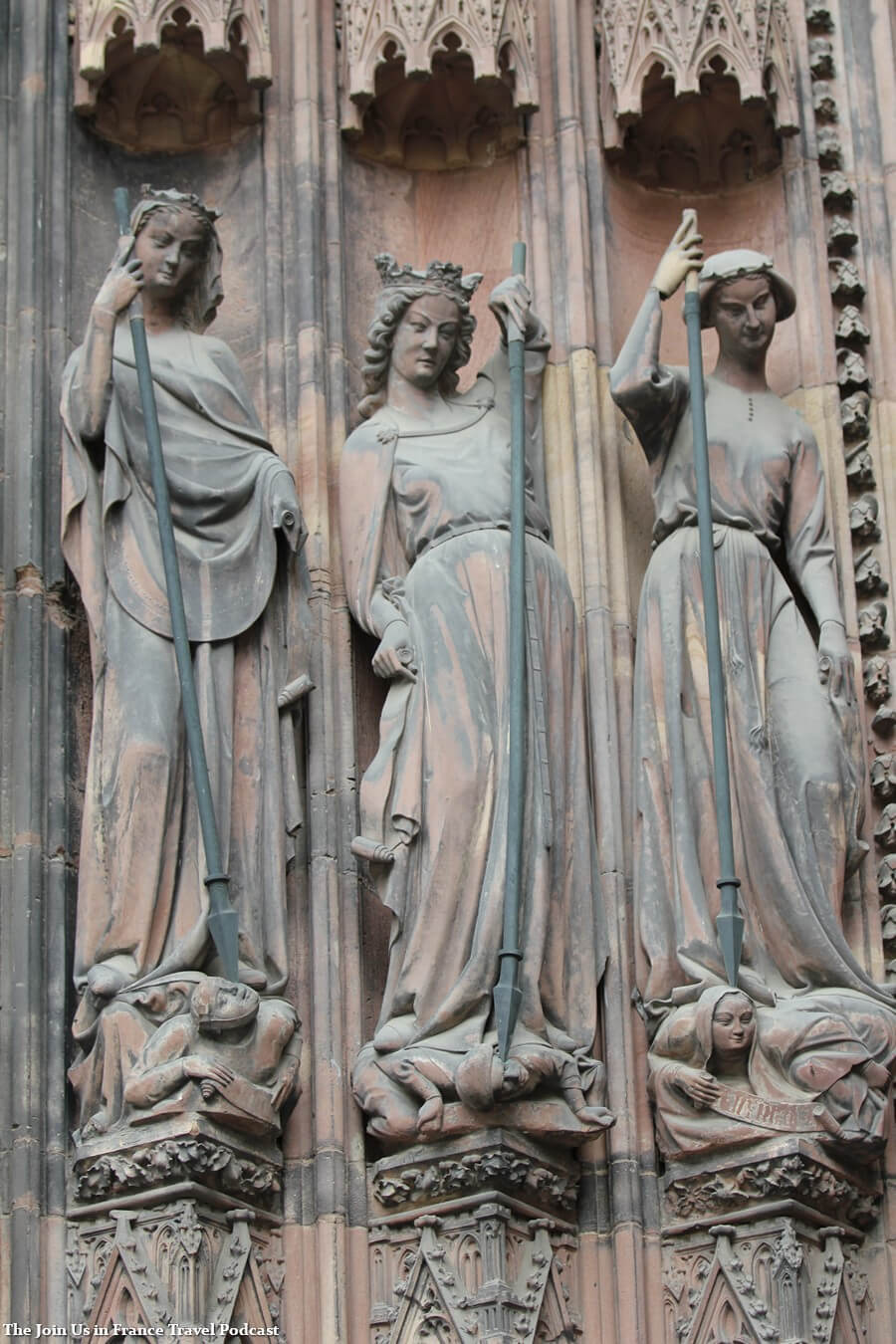
Elise spent a year living in the northeast of France, she was in the Vosges which is the wet side that sees little sun. This is when I spent a lot of time going to Strasbourg and going to all of these beautiful villages on the east side, because I couldn’t stand to not see the sun for weeks at a time. Some people think the area is very Germanic, but so is northern France which was Flemish, there is regional history all over France. To get close to it’s only the culture turns a little bit Italian, if you get close to Catalunya the culture gets very Catalan.
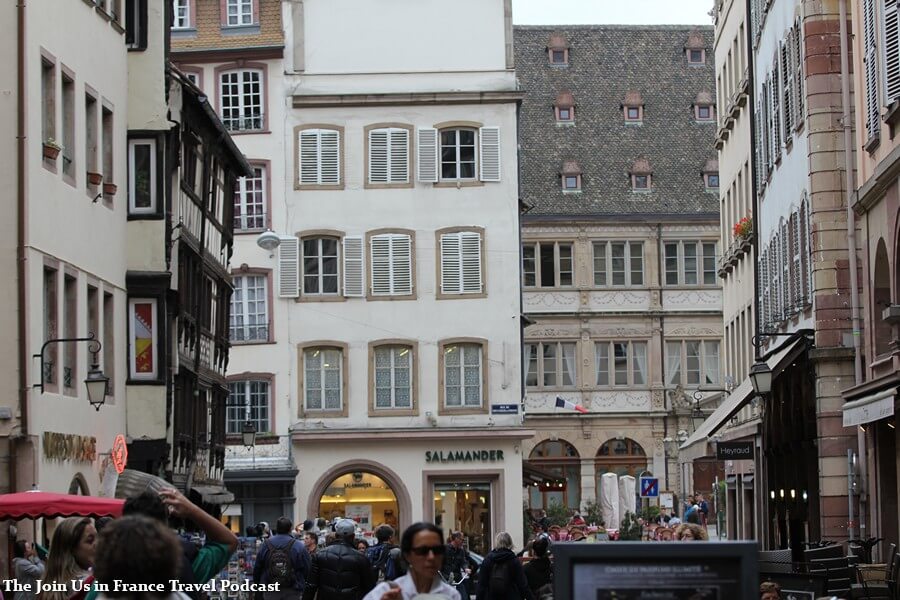
Food and Wine
talk about the most important part of doing nothing like this, which is food and wine! Alsatian wines are very famous, most people of heard of them, Riesling, Gewurztraminer which is a little bit sweet, a famous white, and then the famous red which is Tokay. But the main classical dish that is identified with Strasbourg and all of Alsace is Choucroute. This translates into English as sauerkraut but the name in English does not do it justice. The sauerkraut is just a vegetable, it’s a fermented cabbage, it has been cooked with juniper berries,
Bailey’s and spices. It is served on a huge platter with sausage and big chunks of roast pork, it’s the dish of the region. They have different sausages, they serve it with steamed potatoes. Definitely not a vegetarian dish, although if you just eat the cabbage maybe it would be vegetarian kind of. The cabbages cooked with this wonderful white wine. Sometimes they cook it with champagne, or beer,
or Riesling. If you are going to go there, you really have to try sauerkraut.
The other local dish which is a lot simpler is flammekueche. This is an Alsatian version of pizza dough with onion and cream sauce and bacon bits. Flammekueche is tarte flambée in French. It is really cool, it’s like a pizza but with a sour cream base instead of a tomato base when they can put whatever on it. When I was there I had one with pesto and bitter greens, it was very good and nouvelle cuisine. We didn’t want anything too heavy for lunch. My husband had foie gras
flammekueche. There is a large production of foie gras in the area.If you go to the villages outside of Strasbourg and in the countryside.You will see a lot of geese and ducks walking around. It is a region that produces a lot of foie gras and they do eat goose a lot there. I kept seeing stores that were advertising the
fact that they were selling goose products and I thought those constraints was it’s more Southwest. Goose is what French people associate with Southwest foods. But it is also something that’s traditionally eaten is Western and southwestern Germany as well.
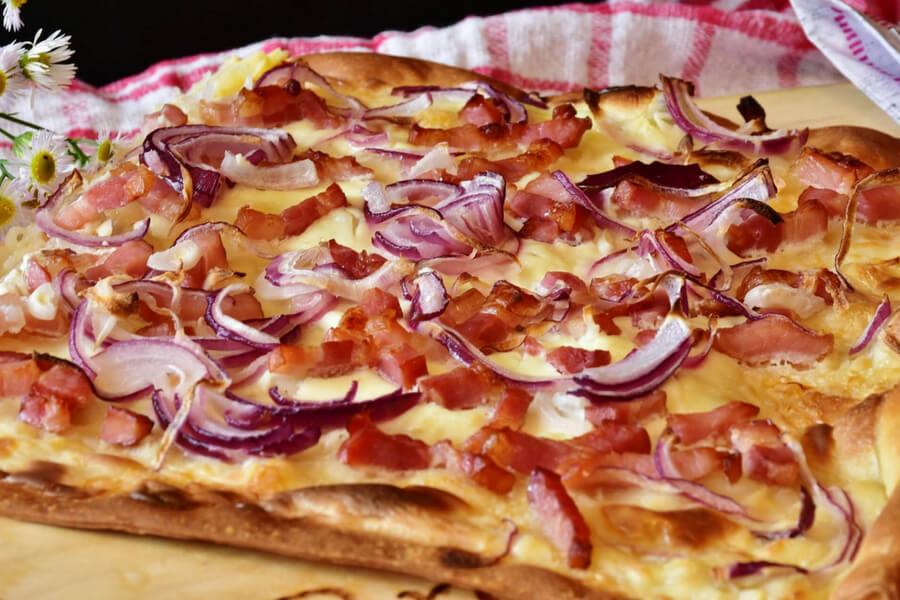
And the last is a desert called kugelhopf (or Kouglof in French). It is a wonderful cake, it is made in a special pan, a bunt cake pan, and it’s the traditional cake that comes from this region. Annie didn’t try it, but it’s very good, it’s like a coffee cake. It’s not gooey, there’s no cream, it’s a basic cake with cinnamon and nutmeg because these are the spices used in the region. I think it’s best with some tea or coffee or something like that. I think the gastronomy of the area is very nice. Definitely very sauerkraut oriented, but it’s really lovely, so I think it’s worth the visit on that account as well.
Is it possible to visit Strasbourg as a day-trip from Paris?
There is a bullet train between Paris and Strasbourg called the TGV, the 400 km takes two hours and 20 minutes so that’s really fast, very modern train. It’s not cheap, the right costs between €80 and €110 one way depending on the time of the day and the day. Actually it’s not so expensive when you consider that it’s a long way to go. You can also take playing, Air France a service between Paris and
Strasbourg. You can get a return plane ticket if you do it in advance for hundred and €170 which basically is the same as a train ticket. And that takes an hour to an hour and 15 minutes one way. But the airport is a little bit out of the way in Strasbourg as with most other major cities. If you want to be in the city center, it’s best to take the train. The train station is right in the middle of the city. I don’t know that I would do it as a day trip from Paris. We think it’s at
least an overnighter. If you spend a full 24 hours and Strasbourg you will get a taste of it, but I would’ve liked to stay an extra day. It’s far enough away from Paris, and there’s enough to see, that it’s worth leaving in the morning one day you stay overnight and then you come back late afternoon on the next day. We didn’t go into a single Museum because we did not have time. I did spend the
whole afternoon in the cathedral checking out all of the gore and art. I would like a kid in a candy store! After a while my husband just left he had had enough. I was doing point-and-shoot point-and-shoot point-and-shoot. I must’ve taken 2000 pictures. I even had some people come up to me and say wow you really like this. And yes, I do. It’s not necessarily the gore, I like the stained-glass windows also!
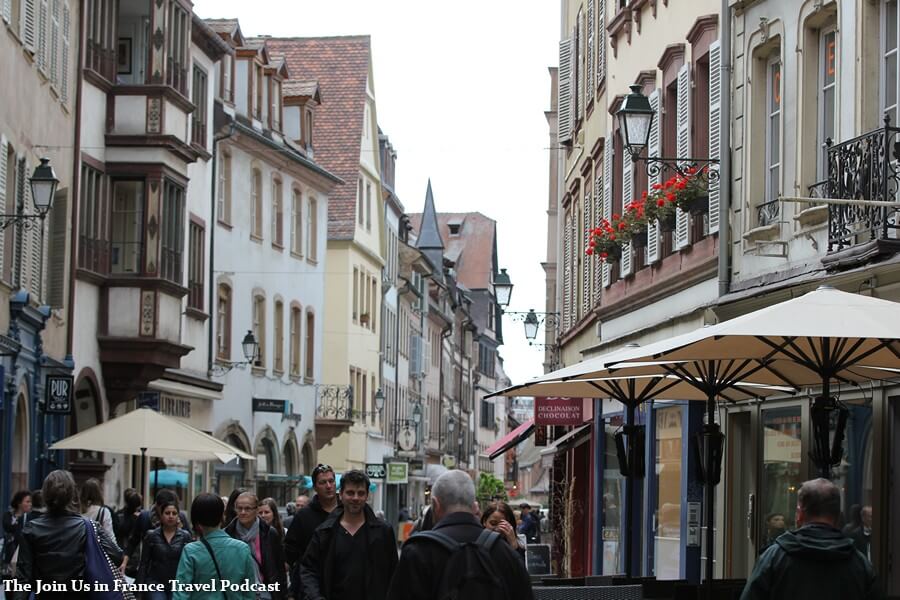
For some reason people don’t talk about the cathedral of Strasbourg as much as they talk about some other places, because it’s associated with Germanic style architecture, and so it’s not included when people talk about Notre Dame de Paris, Chartres, Amiens, and these other cathedrals, even though they’re all Gothic, and they’re all fabulous!
For me it was wonderful because I could see some much more with my pictures than I could with my own eyes, because it’s a little bit dark in there. It’s one of these places where you might walk in and walk out half an hour later thinking while that was nice I couldn’t see very much. So definitely I got more out of it with the pictures than through my own eyes (which is why I’m sharing the pictures with
you on joinusinfrance/18 and https://joinusinfrance.com/strasbourg/) and that’s unfortunate. I think they should light up these churches a little more or have spotlights on the interesting stuff. But then, how do they choose? Because it’s all gorgeous. Yes it is an issue all the time. What do you do in terms of lighting up things that are fragile and sensitive to light? Or how much does it cost to do all of that inside of a huge cathedral? Those are ongoing questions.
There are a few places in the Strasbourg cathedral where you can put a €.50 coin to light up an area for a few minutes. They do that in Italy a lot but not so much in France, but it’s a good idea because at least you see it for a minute or two. But even with the coin it’s not very bright light either. I think they need to make a bigger effort. There were hundreds and hundreds of people in there nobody seems to be complaining so maybe it’s just me nitpicking.
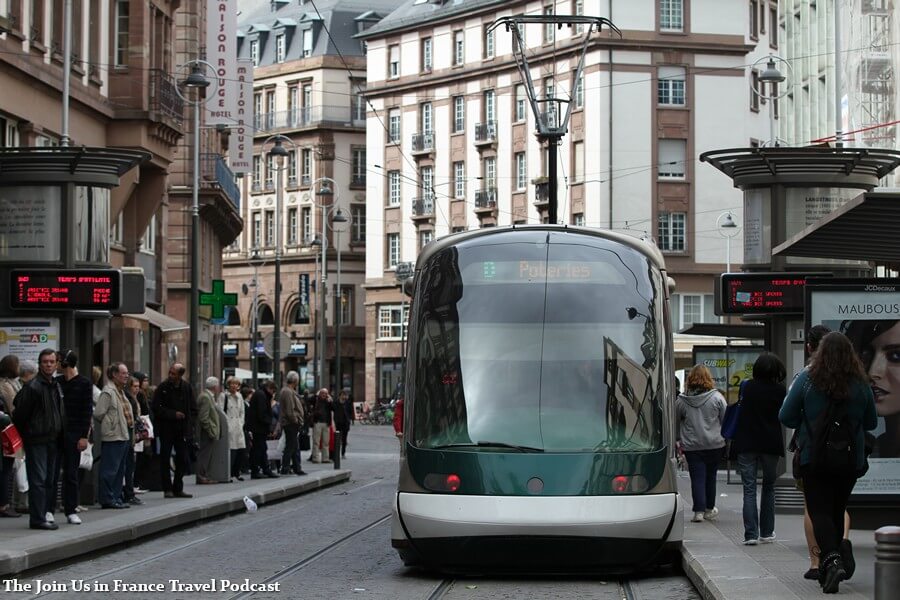
Yes, even if it’s a little bit dark inside, this is definitely a trip that you
should take. So there’s our day in Strasbourg and are Alsatian history.
Wonderful, thank you so muc I would like to remind you that we’re going to start offering some Join Us in France Tours. If you would like to be advised of upcoming towards, just subscribe to the website, that’s the place on the website on the top left-hand side where you see a green button. You put in your email address push the green button that said you’re subscribed. Typically I only send out one email a week, and I’m not planning on doing any more than that. In the email I tell listeners that there’s a new episode, and you can go get it or listen to it. And in that email I will also include information about tours once we have it. Also, next week will be releasing an extra episode on D-Day. It will be a very special episode and it will come out on June 5, 2014.
Thank you very much everybody, we hope you have enjoyed this show, and let us know. If you have questions or comments, we’re always happy to hear from you annie@joinusinfrance.com. And go out and buy a bottle of the Alsatian wine!
Au revoir everybody!
Subscribe to the Podcast
Apple YouTube Spotify RSSSupport the Show
Tip Your Guides Extras Patreon Audio ToursRead more about this transcript
Episode PageCategory: Alsace and Lorraine
